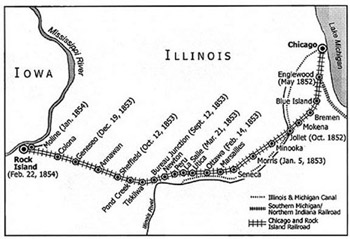

|
|
Empty Nest Magazine
|
The Railroad Tourist: A Rail Fan—the Perfect Travel Companion by James D. Porterfield
A Rail Day in PA
First, on his way to State College, when he gets to Lewistown, PA, I recommend he follow U.S. Routes 522 South/22 West and stay on U.S. 22 West to stop for breakfast at Miller's Diner, 3 miles east of Huntingdon, PA, home to "train stoppin' good food." The “good food” slogan came about when, with the track running so close to the diner, a Conrail crew once stopped their train adjacent to the diner—on orders from their dispatcher, as there was a train ahead of them—and went inside to eat. What they didn't know was that they'd blocked a grade crossing a half-mile back. A passing police officer saw the long line of cars backed up, moved ahead to identify the stopped train as the cause, and eventually found the crew in the diner, where he issued them a traffic citation. After breakfast, a 24-mile drive east on U.S. 22 and south on U.S. 522 to Orbisonia, PA, puts my friend at the East Broad Top (EBT) Railroad in Rockhill, PA. This gem, a National Historic Landmark, is the last operating narrow-gauge railroad east of the Rocky Mountains. Built between 1872 and 1874, the intact highlights include the Rockhill station, a steam-and-belt–powered machine shop, a roundhouse, and a 5-mile excursion drawn by steam locomotives.
Across the tracks, the Rockhill Trolley Museum offers 3-mile trolley rides in several of its 12 city and suburban trolleys, some dating to the 1890s.
With careful planning, and by bringing bicycles along, the couple’s next stop can be the Lower Trail in nearby Water Street, PA, 10 miles west of Huntingdon on U.S. 22. This rail trail is unusual in that it started as an Indian trail and then in the 1830s became a canal—part of the Commonwealth of Pennsylvania's Philadelphia-Pittsburgh "Main Line of Public Works" rail and canal system. Lower Trail meanders along the Juniata River, past remnants of the original Pennsylvania Canal, as well as what remains of old coke and iron furnaces, stone quarries, and earlier bridge supports. My friend and his wife can pedal 12 miles in and enter the borough of Williamsburg, PA, another trail head. Here, our couple can replenish their drinks at a convenience store and ride back to the car.
To cap off the day, the travelers can double back through Huntingdon, pick up PA Route 26 through State College, and join PA Route 144 to Centre Hall, PA, where they'll find the Whistle Stop Restaurant. Alongside the restaurant sits a restored Erie Railroad Stillwell passenger car, the relocated Snydertown flagstop station, and a New York Central wooden caboose. Proprietors Marcia and Ed Gemperle offer a changing menu of railroad French toasts at Sunday brunch. So, in one day, my friend and his wife will enjoy sightseeing in historic locations, good food, nice people, and exercise, all the while making their way to State College. If the spirit moves them, and they allow enough time, they can take in any number of antique and second-hand shops, as well as other museums and historic sights that dot the route. "Be prepared to mosey," I advise him.
Wine Tasting, Anyone? Railroad tourists can indulge and share their interests in the area in several other ways. The Western Sonoma County Historical Society’s West County Museum occupies the former Petaluma & Santa Rosa Railroad passenger depot. The old powerhouse for that railroad is now home to the HopMonk Tavern, a celebrated microbrewery. Sebastopol is also the trailhead for the 13-mile West County and Joe Rodota Rail Trail, the former Petaluma & Santa Rosa Railroad route between Forestville and Santa Rosa. Eighty miles north of Sebastopol, in Niles, CA, the Featherbed Railroad Bed-and-Breakfast Resort offers an interesting respite for the night, with nine cabooses decorated in unique themes—Casablanca, for example, or Wild West, or Tropicaboose.
From the Windy City When I made this trip, I first paused at Joliet's Union Station. The CRIP reached Joliet from Chicago in 1852, and by happy coincidence Amtrak's Chicago–San Antonio Texas Eagle chose that moment to arrive. Back on U.S. 6, I eventually came to realize I was enjoying a memorable experience, 
Courtesy: Augustana College and Cathryn Dowd. "The difference," Hiss writes, "between . . . greatly rewarding trips and the more conventional ones that get you there and bring you back and nothing much more than that, during the memorable trips, people somewhere along the way enter a different part of their own minds, and begin to make use of an awareness that has its own range of interests and concerns and methods. And when the mind is in motion in this way, the experience of travel changes." You see, out of Joliet a succession of little towns and small cities trace the building of the CRIP westward. That they were all once railroad towns is easy to verify: Just head for the center of town. In Morris, you'll find a nicely restored squat brick station standing guard over a single-track reminder that the Rock Island Line's streamlined Rockets once flew by there. Today the building houses the Grundy County Chamber of Commerce Visitor Center. At Seneca, the wooden station shows neglect, but one finds a CSX peddler freight doing local switching. In Marseilles, then Ottawa, neat little brick stations remain in use, whereas in Utica, dilapidation has set in on the boarded-up station. Farther on, the traveler passes through La Salle, where sits the most substantial of these restored stations, to towns like Bureau Junction, Tiskilwa, Sheffield, and Geneseo, all with stations, and to other towns that, despite having lost their stations, offer clues to the route of the railroad. Thus can you spend a pleasant afternoon en route to Arsenal Island in Rock Island, IL, having literally "experienced" the building of the CRIP westward to its historic bridge project. On Arsenal Island, stand in the front parlor of Davenport House, home to one of that early railroad's boosters—George Davenport—and gaze out on the nearby replica of the first bridge pier and the Mississippi River drifting lazily by just beyond. Such pursuits can transcend time and space, making for a deep travel experience anyone can enjoy.
The Perfect Tourist Attraction So whether you and your traveling companions enjoy trains, travel, historic preservation, good food, physical activity, or just picking up some interesting historical facts, railroad tourism serves up something for everyone. With travel destinations that embrace one person’s passion, yet offer so many other choices of things to do and see, a rail fan just may be your perfect travel companion.
LINKS
 Jim Porterfield hosts Journeys for a Railroad Tourist, a website for the travel division of the National Trust for Historic Preservation that includes a blog, book and movie recommendations, links to related articles, an events calendar, and more. His own site—The Railroad Tourist—is a growing state-by-state directory of rail history, travel, and preservation sites throughout the U.S. Jim, also a college marketing instructor, insurance company schools specialist, and cooking aficionado now in his empty-nesting years, is working on several railroad-themed writing projects, including books for children. He is the author of the popular Dining by Rail (St. Martin's Press, 1993) and From the Dining Car (St. Martin's Press, 2004), and he edited and introduced Harry Bedwell's classic railroad novel, The Boomer: A Story (University of Minnesota Press, 2005). Jim Porterfield hosts Journeys for a Railroad Tourist, a website for the travel division of the National Trust for Historic Preservation that includes a blog, book and movie recommendations, links to related articles, an events calendar, and more. His own site—The Railroad Tourist—is a growing state-by-state directory of rail history, travel, and preservation sites throughout the U.S. Jim, also a college marketing instructor, insurance company schools specialist, and cooking aficionado now in his empty-nesting years, is working on several railroad-themed writing projects, including books for children. He is the author of the popular Dining by Rail (St. Martin's Press, 1993) and From the Dining Car (St. Martin's Press, 2004), and he edited and introduced Harry Bedwell's classic railroad novel, The Boomer: A Story (University of Minnesota Press, 2005).
|
Empty Nest: A Magazine for Mature Families
© 2011 Spring Mount Communications